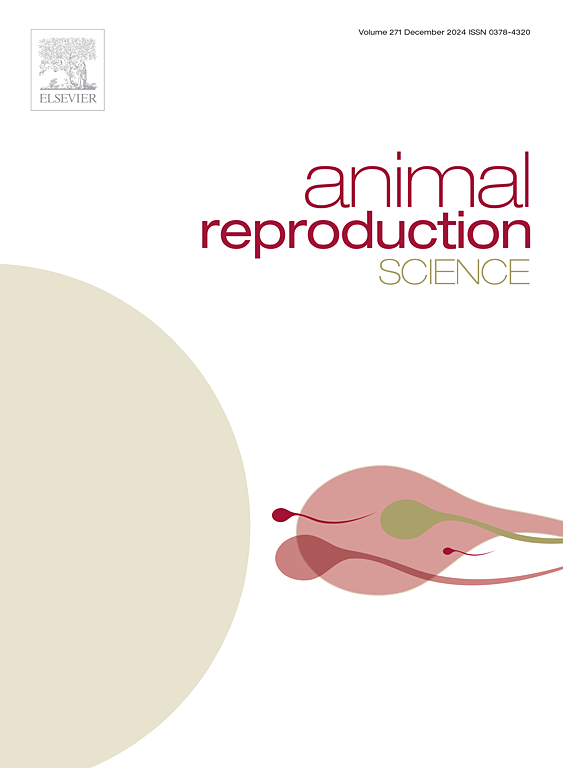Conjugated linoleic acid supplementation: Insights into prostaglandin synthesis and in vitro embryonic development
IF 3.3
2区 农林科学
Q1 AGRICULTURE, DAIRY & ANIMAL SCIENCE
引用次数: 0
Abstract
Modulation of prostaglandin synthesis, specifically, decreasing prostaglandin F2α (PGF2α) and increasing prostaglandin E2 (PGE2) and interferon-tau (IFNT), can support maternal recognition of pregnancy (MRP) in cattle. Conjugated linoleic acid (CLA) is known to influence prostaglandins (PG) synthesis in cell cultures; however, its effect on in vitro-cultured bovine oocytes and embryos remain unclear. We hypothesized that CLA supplementation in oocytes and embryo culture media would reduce PGF2α synthesis, increases PGE2 synthesis and PGE2:PGF2α ratio in embryos, modulate the expression of genes involved in PG and IFNT synthesis, and enhance embryo development. This study aimed to evaluate the effects of different CLA (a mixture of cis- and trans-9,11- and −10,12-octadecadienoic acids) concentrations (50–150 μM) added during in vitro maturation (IVM) and/or in vitro culture (IVC) on in vitro embryo production, PGE2 and PGF2α synthesis, and the expression of genes related to PG synthesis (AKR1B1, PTGS2, PTGES) and MPR (IFNT) in embryos. Oocytes and embryos were treated with CLA (50, 100, and 150 μM) during IVM or during both IVM and IVC. PGE2 and PGF2α concentrations were quantified by ELISA, and transcript abundance in embryos at the end of IVC was assessed by qPCR. CLA supplementation at all tested concentrations during IVM and/or IVC reduced both PGE2 and PGF2α synthesis in embryos, without affecting the PGE2:PGF2α ratio, or the relative expression of the evaluated genes. These findings suggest that CLA modulates PG synthesis in bovine embryos and underscore the importance of PG regulation for the successful establishment of MRP.
共轭亚油酸补充:前列腺素合成和体外胚胎发育的见解
调节前列腺素的合成,特别是降低前列腺素F2α (PGF2α),增加前列腺素E2 (PGE2)和干扰素tau (IFNT),可以支持牛的母体妊娠识别(MRP)。已知共轭亚油酸(CLA)影响细胞培养中前列腺素(PG)的合成;然而,其对体外培养的牛卵母细胞和胚胎的影响尚不清楚。我们假设在卵母细胞和胚胎培养基中添加CLA可以减少PGF2α合成,增加胚胎中PGE2合成和PGE2:PGF2α比值,调节PG和IFNT合成相关基因的表达,促进胚胎发育。本研究旨在评价体外成熟(IVM)和体外培养(IVC)中添加不同浓度(50-150 μM)的CLA(顺式和反式9、11-和- 10、12-十八烯二烯酸混合物)对体外胚胎产生、PGE2和PGF2α合成以及PG合成相关基因(AKR1B1、PTGS2、PTGES)和MPR (IFNT)表达的影响。卵母细胞和胚胎分别在IVM期间或同时在IVM和IVC期间用CLA(50、100和150 μM)处理。ELISA法检测PGE2和PGF2α浓度,qPCR法检测IVC末期胚胎转录物丰度。在IVM和/或IVC期间,添加所有测试浓度的CLA都降低了胚胎中PGE2和PGF2α的合成,但不影响PGE2:PGF2α的比例或评估基因的相对表达。这些结果表明,CLA调节了牛胚胎中PG的合成,并强调了PG调节对MRP成功建立的重要性。
本文章由计算机程序翻译,如有差异,请以英文原文为准。
求助全文
约1分钟内获得全文
求助全文
来源期刊

Animal Reproduction Science
农林科学-奶制品与动物科学
CiteScore
4.50
自引率
9.10%
发文量
136
审稿时长
54 days
期刊介绍:
Animal Reproduction Science publishes results from studies relating to reproduction and fertility in animals. This includes both fundamental research and applied studies, including management practices that increase our understanding of the biology and manipulation of reproduction. Manuscripts should go into depth in the mechanisms involved in the research reported, rather than a give a mere description of findings. The focus is on animals that are useful to humans including food- and fibre-producing; companion/recreational; captive; and endangered species including zoo animals, but excluding laboratory animals unless the results of the study provide new information that impacts the basic understanding of the biology or manipulation of reproduction.
The journal''s scope includes the study of reproductive physiology and endocrinology, reproductive cycles, natural and artificial control of reproduction, preservation and use of gametes and embryos, pregnancy and parturition, infertility and sterility, diagnostic and therapeutic techniques.
The Editorial Board of Animal Reproduction Science has decided not to publish papers in which there is an exclusive examination of the in vitro development of oocytes and embryos; however, there will be consideration of papers that include in vitro studies where the source of the oocytes and/or development of the embryos beyond the blastocyst stage is part of the experimental design.
 求助内容:
求助内容: 应助结果提醒方式:
应助结果提醒方式:


